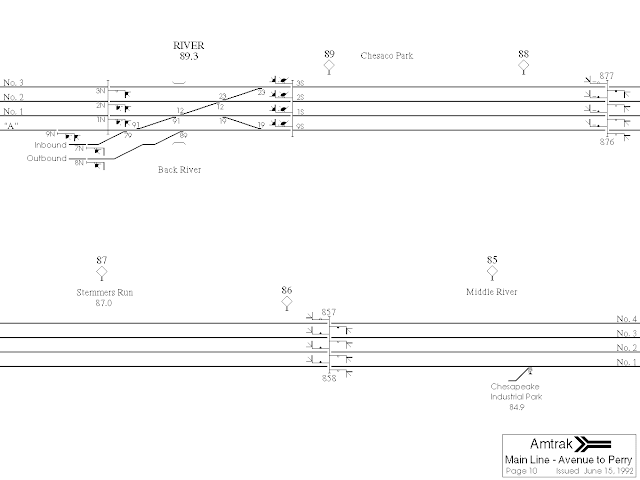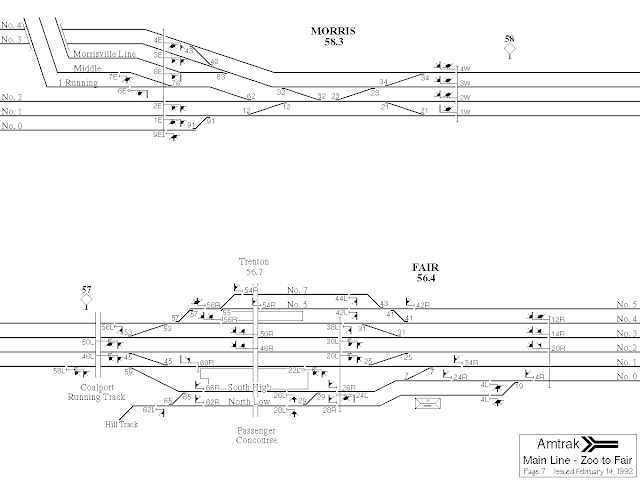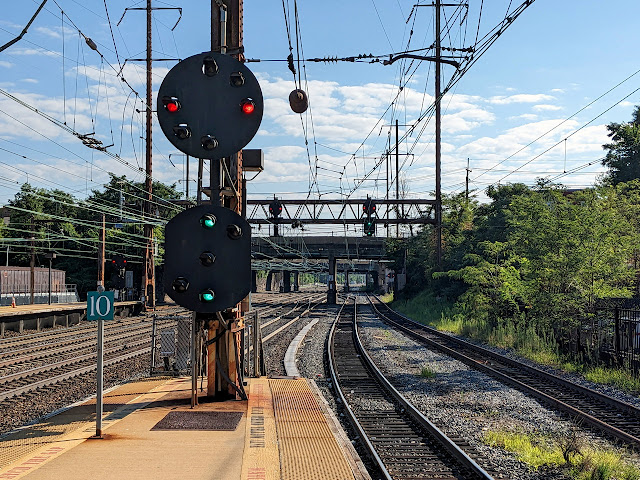Over the first century of its existence the vaunted Pennsylvania Railroad Main Line between Philadelphia and Harrisburg suffered from a significant design flaw around the city of Lancaster. Despite all of the grade separation and curve elimination, trains still had to navigate through Lancaster's downtown grid because when the Philadelphia and Columbia railroad was being built in 1834, the Lancaster establishment lobbied for the route to pass through downtown to better support the local economy. As the decades passed this little detour became unwieldy. A cutoff was constructed north of the city in 1888, but the vast majority of passenger trains still had to take the old route through town because that was there the station was. Finally in the 1920's the PRR had the money and opportunity to construct a state of the art station on the bypass route along with a modern interlocking plant to control the terminal area and PRR Columbia Branch junction. This would be come known as CORK interlocking, after an adjacent Crown Cork and Seal plant and is the next in my deep dives into PRR Main Line interlocking towers.
Opening at the same time as the station in 1929, CORK was a rare, for North America, direct wire area interlocking with an end-to-end length of 3.3 miles. For comparison the sprawling ZOO interlocking in Philadelphia is only about 1.7 miles between its extreme points. Controlled from a relatively modest 67 lever US&S Model 14 interlocking machine, the CORK plant consisted of 4 distinct sections. From east to west there was the "Conestoga" section where 4 tracks converged into 2 and the old line downtown diverged, the east end of the station, the west end of the and Columbia Branch junction, the diamond crossing of the Reading Lancaster Branch over the PRR Columbia Branch and finally the crossing of the same over the PRR Main Line proper. Additionally, CORK had a plethora of interlocked hand throw switches serving local industry scattered along its length.

CORK went through four distinct phases in its layout. The initial 1929 configuration, pictured above, had 4 main track to the east, 4 main tracks in the station area and the full compliment of station support tracks. On or after 1948, track #3 to the east was removed and this marks the second configuration.
Sometime around 1960, as seen above, the PRR implemented a significant rationalization with track #2 to the east also being removed and significant cuts being made to the station terminal support tracks. The final Amtrak era configuration, seen below, saw the end of through/electrified freight operations along with the Reading Lancaster branch and resulted in the removal of Columbia Branch portion of the interlocking plant.
Starting at
the extreme eastern end of the territory we find the Conestoga section, likely named for an earlier tower covering the New Holland Branch and the squeeze from quad to double track to pass over the
Conestoga Creek viaduct that the
PRR never bothered to widen. The Main Line was 4-track to this point until 1948 when either track 2 or 3 was removed as most through freight could be accommodated on the A&S Low Grade Line branching off at Parkesburg. In 1929 Main Line at this point was ABS Rule 251 so all reverse direction movements would be provided with dwarf signals. The old 4-track beam gantry carries the remaining 2R signal with the 4R dwarf on the ground. It is currently not clear if the post 1948 third track was bi-directional or a second ABS track in the direction best able to support slow freight trains on the Main Line's infamous grades.

The ~1960 reconfigured Conestoga section saw the addition of a trailing point crossover set adjacent to the lever 16 locked New Holland Branch connection. Possibly intended to allow eastbound trains to use the eastbound platform or something with local movements, the #1 crossover was not very useful in the Amtrak era with typically rusty rails and the overhead catenary removed. The "hacked" nature of the #1 crossover is evident from the dual level westbound dwarf signal that is cleared by the 4R with #1 normal and 2R with #1 reverse. When CORK was rebuilt, the New Holland Branch switch was upgraded to power operation, which would have required additional modifications to the CORK Model 14's logic in the 2007 time frame.

The west end of the Conestoga section is located west of the viaduct at the point where the old alignment would veer south towards the downtown. In the 1929 configuration this would be the east end of a second stretch of 4-track main line running from the Conestoga section through the Lancaster Station proper with tracks 1 and 4 having interlocked hand throw industrial leads. The intent appears to minimize the conflicts between freight and passenger trains east of the station. After 1960 the need for 4 main tracks in this area was eliminated so both tracks 1 and 4 west of Conestoga were relabeled as Ewd and Wwd Station Tracks with the eastern 5700 feet of the old track #4/Wwd Station converted into an industrial lead and the #5 switch removed.

Although labeled a "station track", the eastern part of the old #1 track to the 20L still had up to 8 hand throw industrial spurs locked by the 30 lever so trains stopping at Lancaster would likely return immediately to track #1 via the #11 crossover. Later, the #7 switch would be reduced to slow speed operation as evidenced by the lack of medium speed route on the 20L on the far right of the signal bridge shown below. Entrance into the Conestoga section was governed by the 6L high signal on the post-1948 track #1 and the 2L dwarf on post-1948 track #2.

A mile to the west we encounter the station terminal area. As a clean sheet modern design, the Lancaster station was equipped with high level platforms that avoided issues with freight clearance via the provision of two non-platformed through tracks like Trenton and North Philadelphia. In the 1929 configuration each island platform supported 2 tracks, a main track and an additional station track numbered A and B. On the southern side of the station and additional through freight track numbered 0 could carry eastbound Columbia Branch freights and a further Express Track served Lancaster Station's dedicated high level mail and express platform. A further mail/express/engine stub track was built into the west end of the westbound platform.

After the 1950's both tracks A and B were removed along with the westbound stub track. From then on the east station section of CORK featured the #15 switch from track #2 onto the westward station track and a facing point ladder from track #2, through track #1 to access the eastward station track and #0 express track. Westbound movements were governed by the 10R high signal and the 12R and 14R dwarfs.
Starting in 2005, the east end of the station would be reconfigured for the final time with a full crossover in conjunction with the removal of both station tracks. Here in this 2005 photo from the east end of the westbound platform you can still get the jist of the PRR layout.
Eastbound trains on the old station track would be governed by the 14L high signal that also allowed for straight routes to the extension. With the end of through freight, the center track #1 and #2 saw little use in the late Amtrak era and when the Harrisburg Line was reconstructed in the 2000's the station tracks were removed and the main tracks ultimately relocated to serve the high level platforms.




















































